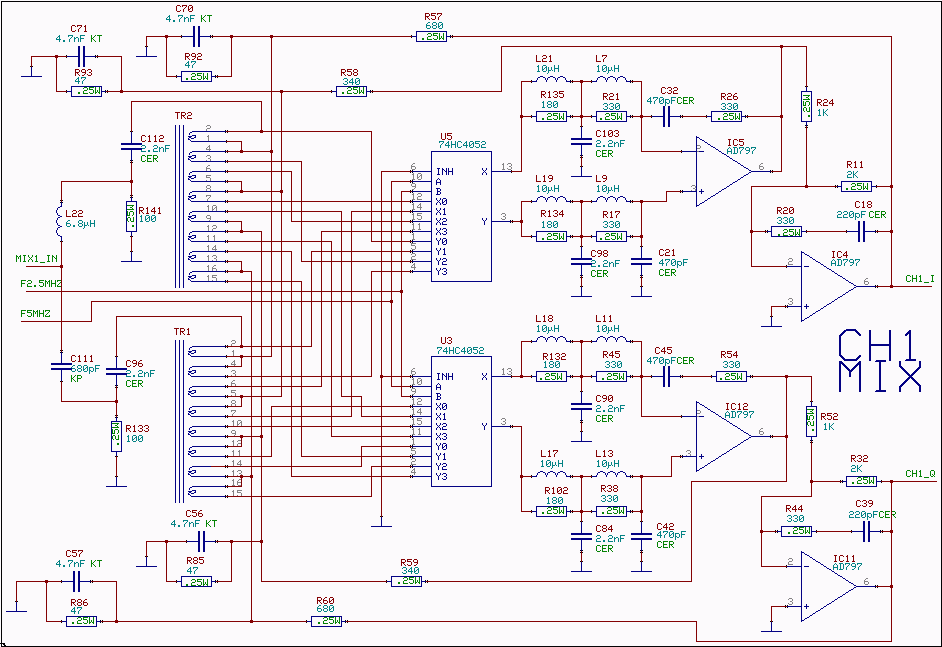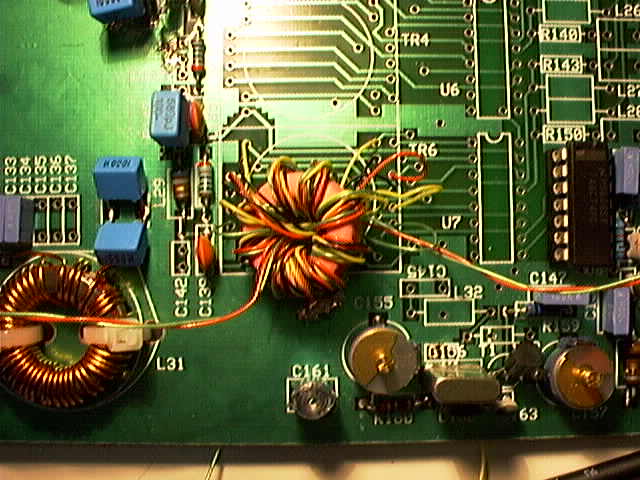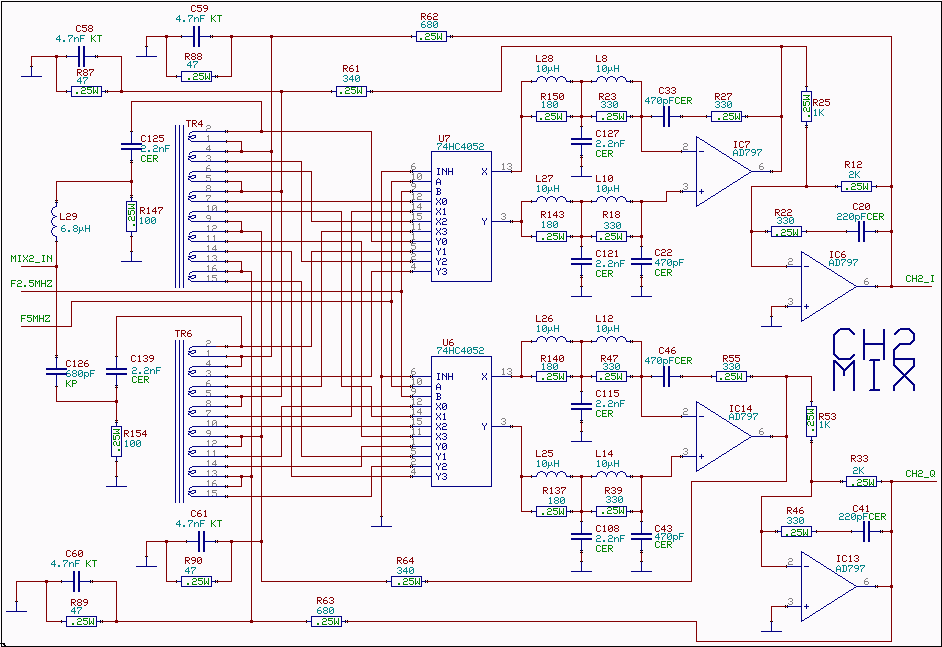
Fig. 2. The mixer transformer. 8 x 10 turns of wirewrap wire.
|
Conventional switched mixers have a switch that alternates between
two positions controlled by the LO frequency.
A simple design like the one
described with My old MSDOS version of PC radio
has several limitations.
The 4053 switch is make before breake so the input circuit is
shortcircuited for a short period each time the switch changes state.
Unless some extra components are used the current pulse causes
distorsion.
The pulse is short and contains harmonics of the RF signal that
will mix with the LO overtones and cause audio overtones.
The 74HC4053 switch is "typically break before make" according to
the data sheet.
Still it gives relatively high levels of audio overtones for
reasons I do not understand.
To avoid the short circuit condition one can use 4 to 1 switches. The mixer 74HC4052 mixer with two-phase RF input is an improvement over the 74HC4053 design but both these designs have a serious problem in that they do not present a suitable (low) input impedance for the first audio amplifier. These switched mixers have a low impedance at the RF side. If a capacitor is placed from the output to ground, large currents of RF harmonics will flow through the switch which would generate overtones. The audio amplifier (with its capacitance to ground) is therefore connected through a large resistor, 1 kiloohm, which will add a significant amount of thermal noise to the audio signal. In order to make the audio impedance low at the output, the RF signal is shifted by 90 degrees and fed to a toroid so the four positions of the switch see the phases 0, 90, 180 and 270 degrees of the RF signal. This way the output always provides a very low AF impedance to ground. The 4052 is also make before break but since it is four-phase the voltage across the short is half compared to the 4053 solution. Also because of the higher switch frequency the audio overtone levels are much smaller. Figure 1 shows the mixer and audio amplifier. An inductor in series with the output limits current pulses through the switch. The 180 ohm resistor makes sure the voltage across the inductor does not reach too high when the switch is turned off. The audio impedance seen by the op-amp is 100 ohms. The mixer provides 50 ohms and the feedback resistors add 47 ohms. With a low audio impedance it is meaningful to use a really good audio amplifier like the AD797. In order to take advantage of the positive input of the op-amp, two identical mixers are used with the RF signal shifted 180 degrees. This way the AD797 will see 6dB more signal voltage but only about one dB more noise. The secret behind the exceptional linearity is that the audio amplifier does not use feed back to the input pin - feedback is applied on the other side of the mixer. As a consequence, The output voltage of the mixer is kept at zero all the time It is the midpoint of the transformer winding that has the audio frequency swing. There is no current through the switches. Firstly because there is no load at the output side, secondly because the voltage at the other side of the switch is forced to zero by the feedback. Since there are two mixers a second op-amp is added to provide a source for feedback to the mixer that feeds the positive input of the AD797. For minimum noise the feedback resistors have to be low. In order to allow very strong signals the gain must be kept low. The first AD797 is loaded by 340 ohms only but since it always has half the voltage swing of the second AD797 it does not have to deliver more current. The load impedance of 600 ohms for full output voltage swing forces the feedback resistor to be as high as 47 ohms to not get too much gain. Note that the AD707 is very sensitive for RF at the input pins. The second coil and resistor help to reduce the switch transients from the 74HC4052 output. Actually the filtering is only RC links. The 10 microhenry inductors are present to make the audio impedance very low so the filter resistors will not add thermal noise. The inductance of the toroid is balanced with a capacitor and the impedance is set to 100 ohms with a resistor. The mixers are fed through a capacitor and an inductor respectively so they are +/- 45 degrees out of phase compared to the input signal. This way the upper and lower mixer pair differ by 90 degrees over a wide frequency range.
|


Fig. 2.
The mixer transformer. 8 x 10 turns of wirewrap wire.

Fig. 3.
With 4 colours of the wirewrap wire one can make the four
different twisted pairs required to connect the windings without
an ohm-meter. Untwist one pair at a time and put each wire
in opposite holes at the same height as is shown here.
Finally remove, deinsulate and solder one wire at a time.
All holes at the left side should be connected to wires
wound in the same direction.

Fig. 4.
The second channel is identical.
Only the component numbering differs.